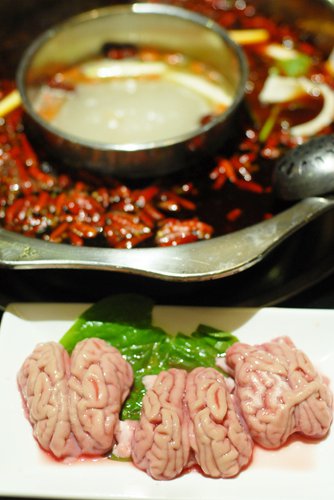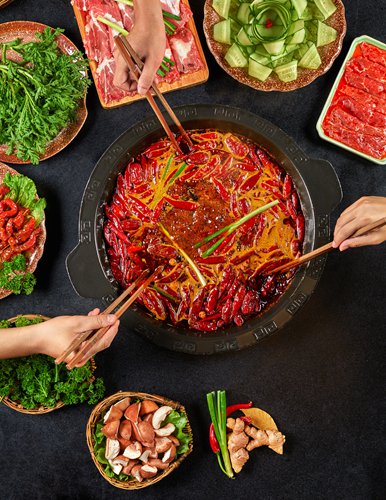
Photo: IC

Photo: VCG
"If you could make any dish in the world disappear, what would it be?"
When this question was asked of Chua Lam, a well-known Singaporean columnist and food critic, while he was on Chinese talk show Day Day Up in December of 2018, his answer was unexpected and quite shocking.
"I'd make hot pot disappear, I suppose."
"Because hot pot is one of the most uncultured ways of cooking. You just cut everything up and throw it in a pot of broth," Chua explained.
Unsurprisingly, his comment drew strong opposition from netizens in China, where hot pot is seen as the perfect traditional winter activity for bringing friends and family together. And even more important, it's tasty.
Imagine putting thinly sliced beef or mutton, sweet and fresh prawn, crispy vegetables and soft tofu into a pot of delicious soup, which can come in many varieties such savory tomato or mushroom broth or Chongqing's famous spicy broth. After just a few seconds, those ingredients soak in the flavors of your chosen soup and are now ready to be fished out with chopsticks and dipped into a sauce, which each person around the table has tailored to fit their own personal tastes by adding ingredients such as sesame oil, sesame paste, soy source, chili sauce, minced cilantro and garlic.
While you can't go wrong with the above ingredients, for most Chinese people the peak of hot pot perfection comes when you bring in ingredients such as beef tripe and duck intestines, organ meats that are transformed into amazing delicacies through the magic of hot pot.
For those new to hot pot, our recommendation is to not ask what you are eating as you and your friends gather around the table; just gather your courage, open your mind and give different things a try. For those who are already familiar with hot pot, below are the Global Times' top five "internal" ingredients you should try the next time you have hot pot.
1. Pig brains
A very nutritious food, pig brains commonly appear on the dining tables of many families around the world.
The texture of pig brain is smooth and creamy, just like tofu or steamed egg. Lacking the strong odor that many other animal organs have, pig brains are absolutely delicious when used in hot pot. This is especially true with spicy broth as the slightly sweet and fatty taste of the soup, the aroma of pepper and herbs from the broth helps lessen scent of the pig brains, which beginners may find unusual at first. For those who are fans of Haggis or blood pudding, you are sure to find this a tasty treat.
This particular ingredient is high in cholesterol, so those who need to watch their intake should enjoy it in moderation.
2. Ox aorta
This ingredient has quite a deceptive appearance as ox aorta looks like a piece of smooth white jade.
Known as huanghou in Chinese (lit: yellow throat), ox aorta is another popular ingredient for hot pot. Located in the left ventricle and the largest artery in the heart, this aorta must handle a lot of pressure and so is extremely strong. Therefore, the texture of huanghou is chewy and tough. This texture is this ingredient's main draw as it doesn't have much flavor of its own and so depends heavily on sauce and spicy broth for added taste.
Huanghou should not be boiled for more than 10 seconds while you are dipping it in the broth or it will become too tough to chew. We recommend readers count from one to eight while cooking a piece of huanghou, this timing should ensure it remains crisp and tasty.
3. Duck intestines
Duck intestines are amazing to look at as their color and texture make them appear like pieces of salmon-colored silk. Much thinner than huanghou, duck intestines are a good partner for Chongqing spicy hot pot, which helps reduce the strong scent of the intestines while preserving their taste and flavor.
Loved by locals in Chongqing and Sichuan Province, the most local way to eat duck intestines is to use the "seven up, eight down" method, which means dipping the intestines in and out of the boiling broth eight times. Like the aorta, this ensures the intestines stay crispy and don't become too chewy.
4. Fish maw
Fish maw refers to the dried fish bladders of the giant yellow croaker. For those that usually avoid fish, it is worth mentioning that this ingredient does not have a fishy smell, while its spongy texture helps absorb the flavors of the soup and other ingredients. It is a perfect ingredient for both spicy and non-spicy broths. After boiling, the texture of fish maw becomes soft and slippery, a texture similar to boiled pig's feet.
5. Beef tripe
Unlike the other ingredients we've talked about, beef tripe is a very popular ingredient in China and is not limited to hot pot. Chinese people's love for its crunchy and crispy texture makes tripe a must-order dish in hot pot restaurants. Even Chua admitted he loves beef tripe.
"I love beef tripe most in hot pot […], you will never forget that crispy and pleasant aroma that comes with a big bit of tripe. Hot pot without beef tripe is simply incomplete," Chua posted on Sina Weibo in August 2018.
If beef tripe has the magic to make a "hot pot objector" surrender, why wouldn't you want to have a try?
Newspaper headline: The ‘inside’ story











